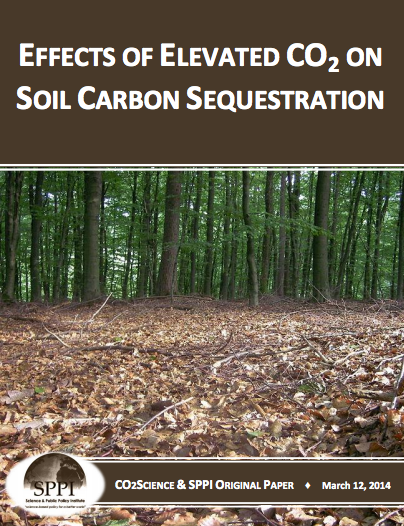News / Random
Effects Of Elevated CO2 On Soil Carbon Sequestration

It is important to note at the outset that atmospheric CO2 enrichment typically has but a small effect on the decomposition rates of senesced plant materials present in soils; yet this fact often leads to significantly greater soil carbon sequestration, as demonstrated by De Angelis et al. (2000)1, who reported a 4% reduction in the decomposition rate of leaf litter beneath stands of 30-year-old Mediterranean forest species enriched with air of 710 ppm CO2, and who thus concluded that "if this effect is coupled to an increase in primary production [which nearly always occurs in response to elevated CO2] there will be a net rise of C-storage in the soils of forest ecosystems." Similarly, in a study of soybean and sorghum plant residues grown at 705 ppm CO2, where decomposition rates were definitely not impacted by elevated CO2, Henning et al. (1996)2 still concluded that "the possibility exists for increased soil C storage under field crops in an elevated CO2 world," due, of course, to the greater residue production resulting from CO2-enhanced plant growth.
In a study that revealed how these phenomena once manifested themselves in a field of clover (Trifolium repens L.) at the Swiss Federal Institute of Technology near Zurich, a 71% increase in atmospheric CO2 concentration increased above ground growth by 146%, while it increased the pumping of newly-fixed carbon into the soil of the CO2-enriched plots by approximately 50% (Nitschelm et al. 19973). In addition, root decomposition in the CO2-enriched plots was found to be 24% less than in the ambient-treatment plots; and, therefore, the researchers concluded that "the occurrence at elevated CO2 of both greater plant material input, through higher yields, and reduced residue decomposition rates would be expected to impact soil carbon storage significantly." And in a similar study of the effects of a doubling of the air's CO2 concentration on three different grass species, Cotrufo and Gorissen (1997)4 concluded that"elevated CO2 could result in greater soil carbon stores due to increased carbon-input into soils."
One year later, Verburg et al. (1998) 5 grew one-year-old heather plants (Calluna vulgaris L.) for two months in greenhouses maintained at atmospheric CO2 concentrations of 380 and 580 ppm in combination with low and high levels of soil nitrogen before exposing them to 14CO2 for one day, in order to study the fate of recently-fixed carbon in their experimental plant-soil system. This work revealed that the extra CO2 increased net 14C uptake in heather by approximately 43%, irrespective of soil nitrogen content. In addition, soil 14C increased in elevated CO2 plots by 17 and 25% at low and high soil nitrogen levels, respectively. In addition, although total soil respiration was initially higher in the CO2-enriched plots (for two days post14CO2 labeling), it declined to become significantly lower than the soil respiration rate displayed by plots exposed to ambient air within two weeks; and that trend persisted throughout the remaining four weeks of the study. Thus, it would appear that soil carbon sequestration beneath heather communities will likely increase in the future with further increases in the air's CO2 concentration.
